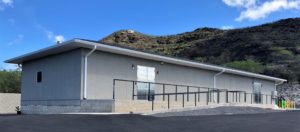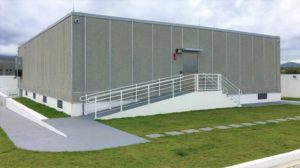Brian Lavallée senior director, solutions marketing at Ciena, looks at the pivotal role of the landing station in the subsea sector
The Changing Subsea Landscape
The submarine networking industry continues to experience significant churn with a sea change of innovative new technologies finding their way into building intercontinental networks, overland and undersea, such as coherent optics, artificial intelligence, encryption, packet switching, and much more. These technologies, alongside the pioneering PoP-to-PoP transoceanic networking designs, have and will continue to change how end-to-end intercontinental networks are designed, deployed, managed, and maintained now and into the future.
Although much attention is understandably focused on the optical wizardry that has allowed submarine network operators to reach previously unthinkable total information-carrying capacities on both legacy and new submarine cables, there’s another part of the end-to-end network connection that’s critically important – the Cable Landing Station (CLS). This often-overlooked part of the global network infrastructure is often where submarine networks meet terrestrial networks. As is the case with networking technology, the CLS has and will continue to experience advances allowing submarine cable operators to build increasingly reliable end-to-end intercontinental networks.
Transmitting more than 95% of the world’s telecom traffic, submarine networks have never been more critical to global voice and data communications. Submarine cables and their connections to terrestrial networks enable real-time access to business and consumer applications, social media, streaming video, websites, and many other bandwidth-intensive services. This traffic flows through network equipment in a CLS, which impacts how the CLS is designed, deployed, and managed.
The ongoing increases in global bandwidth growth is also associated with a steady price erosion for intercontinental submarine capacity, and yet the frequency at which new cable projects are announced is an indication that demand for undersea infrastructure is likely to remain high. A main concern facing submarine cable owner-operators in the coming years is how to significantly reduce the operating costs of their networks.
Additionally, although the submarine cable industry is undergoing a surge in new builds, much of the existing infrastructure that was put into service between 2000 and 2001 is nearing end-of-life and will soon face retirement. That means more new cables deployed on existing routes and expansions of networks will become necessary — not just linking major global hubs, but emerging and underserved markets as well. Thus far, hyperscale Internet companies have focused their investments on building new cables on transatlantic, transpacific, U.S.-Latin American, and intra-Asian routes. However, other new submarine arteries linking Europe to Africa, India to Europe, and India to Singapore are also becoming the focus of cable owner-operators.
Driven by a surge in global bandwidth demand and an increasingly borderless digital economy, the rate at which new submarine cables are coming online calls for a new paradigm in submarine network architecture as well as a new means of procuring, designing, and building a CLS at the systems’ endpoints.
In a CLS, submarine networks interconnect to inland terrestrial networks, typically via a backhaul network into the carrier’s inland Point-of-Presence (PoP). To protect revenues and margins while combatting ongoing price erosion, submarine cable owner-operators are identifying the CLS as a key area in the network where significant reductions in power consumption, space allocation, equipment complexity, and construction and operating costs can be achieved. One a related note, this is a primary benefit – simplification – of modern PoP-to-PoP network designs, which eliminate a significant amount of networking equipment when compared to traditional, and now obsolete, architectures of the past. Today, equipment located in a CLS can fully leverage the more rapid technological advances of terrestrial optical networks and associated cost savings from higher production volumes.

Figure 1: Modern Cable Landing Station (CLS) Exterior (Courtesy: XSite Modular)
Most CLS’s use traditional “stick-build” construction whereby various components are transported to a site and then put together into a final product at great cost, time and labor. Compounding this challenge, stick-built CLS’s constructed in many countries may involve firms lacking adequate experience in the design-build of these highly specialized buildings. This leads to creating one-off solutions without an understanding of the complete use case and nuances of equipment layout and selection, which can have a significant negative impact not only on performance but future operational costs. For example, today’s smaller, denser submarine network terminals allow for more compact building specifications.

Figure 2: Cable Landing Station (CLS) Interior (Courtesy: XSite Modular)
To reduce deployment timelines, the use of modular design-build methods in the form of Modular Cable Landing Stations (MCLS), built in a controlled environment by experienced labor, offer the advantage of integrating design flexibility to meet the specific technical requirements of a new subsea cable project. Modular design-build processes also provide cost certainty from the earliest concept phases through completion. Providing the advantages of a Containerized Cable Landing Station (CCLS) solution but possessing much higher quality, resiliency and durability than either traditional site-built CLS’s or containers, MCLS are defined as permanent steel and concrete buildings designed to a 50-year plus lifespan, so they are built to last well into the future.
Because they are coastal installations, all CLS’s must possess the structural resiliency to withstand extreme weather and other adverse events. MCLS can withstand the worst natural disasters, security threats and failure scenarios, including heavy wind and seismic loads. As proof, we need only look to this past October, when Super Typhoon Yutu struck the Pacific Islands including the hardest hit Island of Tinian. With maximum gusts of up to 190 miles per hour, some CLS’s remained standing and continued to perform as expected. A typical MCLS provides such critical services as cooling, ventilation, fire detection and suppression, AC backup power, cable management, access control, video surveillance, and a building management system, among others. These types of CLS’s can be designed as hardened structures to perform under physical threats, natural disasters, and system failure.
Taking Submarine Network Architecture to the Extreme
Emerging technologies that will continue to influence CLS network designs include 40G and 100G terrestrial-facing and submarine-facing coherent DWDM line optics, intelligent control plane-based mesh networks for improved flexibility, availability, and optimization, and the migration of terrestrial networks from circuit-switched services to packet-switched services.
Terrestrial networks have been moving toward packet-based systems because they offer many benefits, including statistical multiplexing, over-subscription and economies of scale. Enabling submarine network operators to enjoy the same advantages as their terrestrial counterparts, such as packet switching, undersea cable operators can seamlessly carry packet services from end-users to data centers and everything in between, whether transmitting data overland or across vast transoceanic distances between continents.
In viewing the network from the end-to-end service paths, PoP-to-PoP network designs blur the lines between submarine and terrestrial networks while adding a significant number of new features and technologies built on cloud-based software innovation. Beyond enabling submarine cable operators to scale information-carrying capabilities, intelligent mesh network protection protects terabits of traffic from inevitable cable faults and lowers the total cost of network ownership to protect revenues and margins.
Where there’s an absence of existing data centers near landing points that prevents cable owner-operators from directly connecting their networks via PoP-to-PoP configurations, Submarine Line Termination Equipment (SLTE) and intelligent mesh protection equipment can be integrated into MCLS or a hybrid MCLS/data center to secure much needed connectivity. This is especially the case as more emerging and undeserved markets are reached by new or expanding subsea cable systems, including many markets throughout Africa, Central and South America, and Asia.
It’s quite clear that the Cable Landing Station is critical infrastructure in the end-to-end service path.

